
Redefining sustainable shopping through AI
A hyper-personalized shopping experience that helps you do more with what you own.Project Overview
Duration
3 months / Self-initiated
Project Brief: The study will explore the application of design management practice and theory to develop and design strategies that bridge the gap between consumers' beliefs and actions.
My Role
Owning the end-to-end process of diagnosing, defining, ideating and developing a human-centred solution to reduce Gen Z and Millennials' cognitive dissonance regarding sustainable fashion.
(Visual Design by Tanya Kar)
Mentors
Jon Denham - (Chair, Design Management and Service Design)
Tom Hardy - (Professor, Design Management)
John Storey - (Professor, Design Management)
Project Purpose
The purpose was to understand the consumers’ perception of sustainable fashion, their buying behaviour and the factors governing cognitive dissonance. The aim was to bring about a behavioural change, and the insights gathered helped me develop a solution that empowers consumers to make responsible fashion choices.
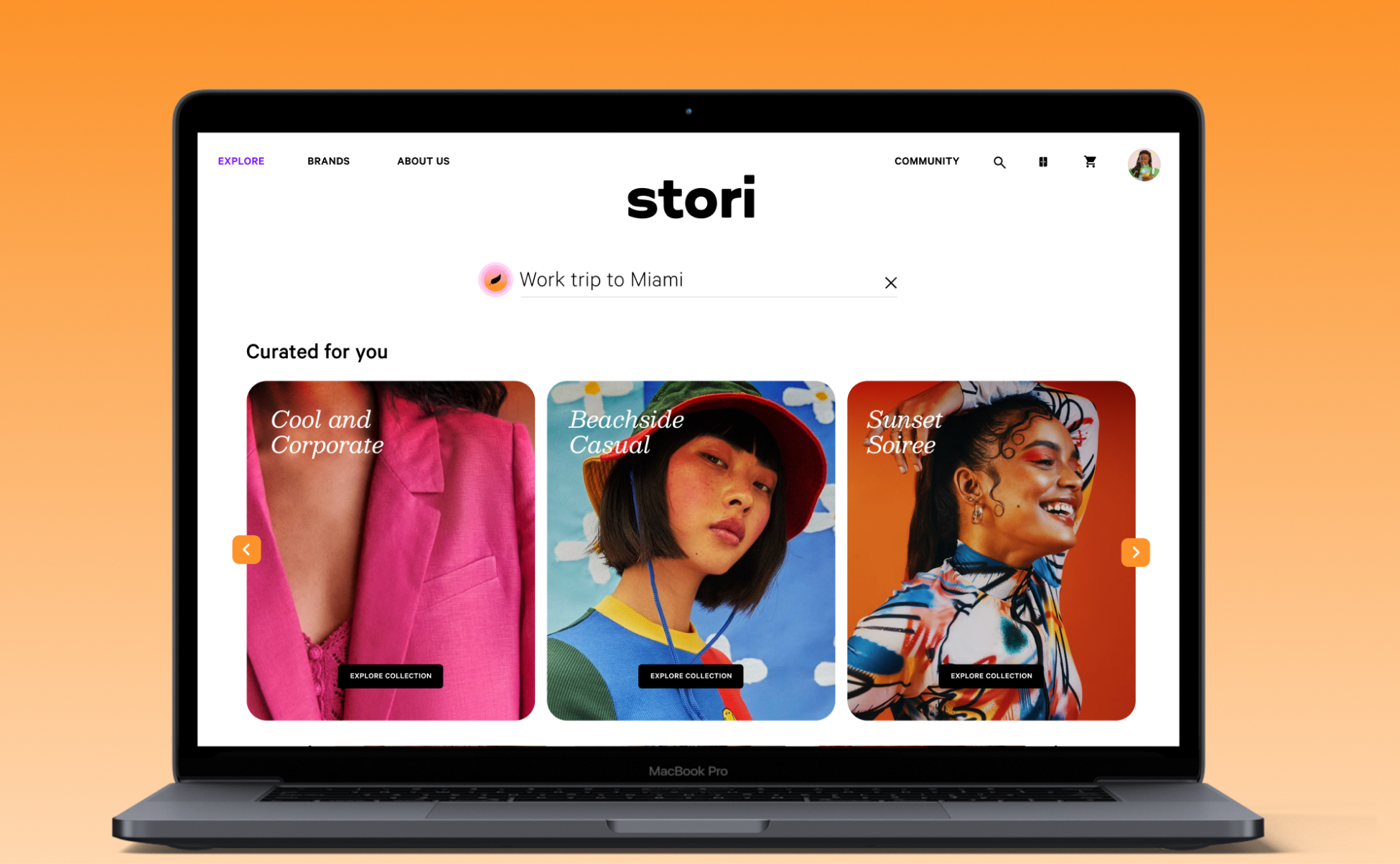
The Problem
Despite a strong desire to support sustainable fashion, Gen Z & Millennials still find unsustainable brands more appealing and accessible. A gap exists between consumers' beliefs, behaviours, and their actual consumption of sustainable apparel, leading to cognitive dissonance.


How might we create an engaging and immersive sustainable buying experience that motivates, educates and empowers consumers to make sustainable apparel their lifestyle choice?
Solution
Through the pillars of Explore, Educate, Curate and Connect, the designed solution empowers consumers to be mindful with their purchases & live their values without compromize. I designed an AI retail platform that integrates consumers' existing wardrobes with personalized recommendations from sustainable brands. It focuses on inducing a responsible consumption behaviour by maximising consumers’ existing wardrobes.Ensuring every new piece complements their style, values, and personality.
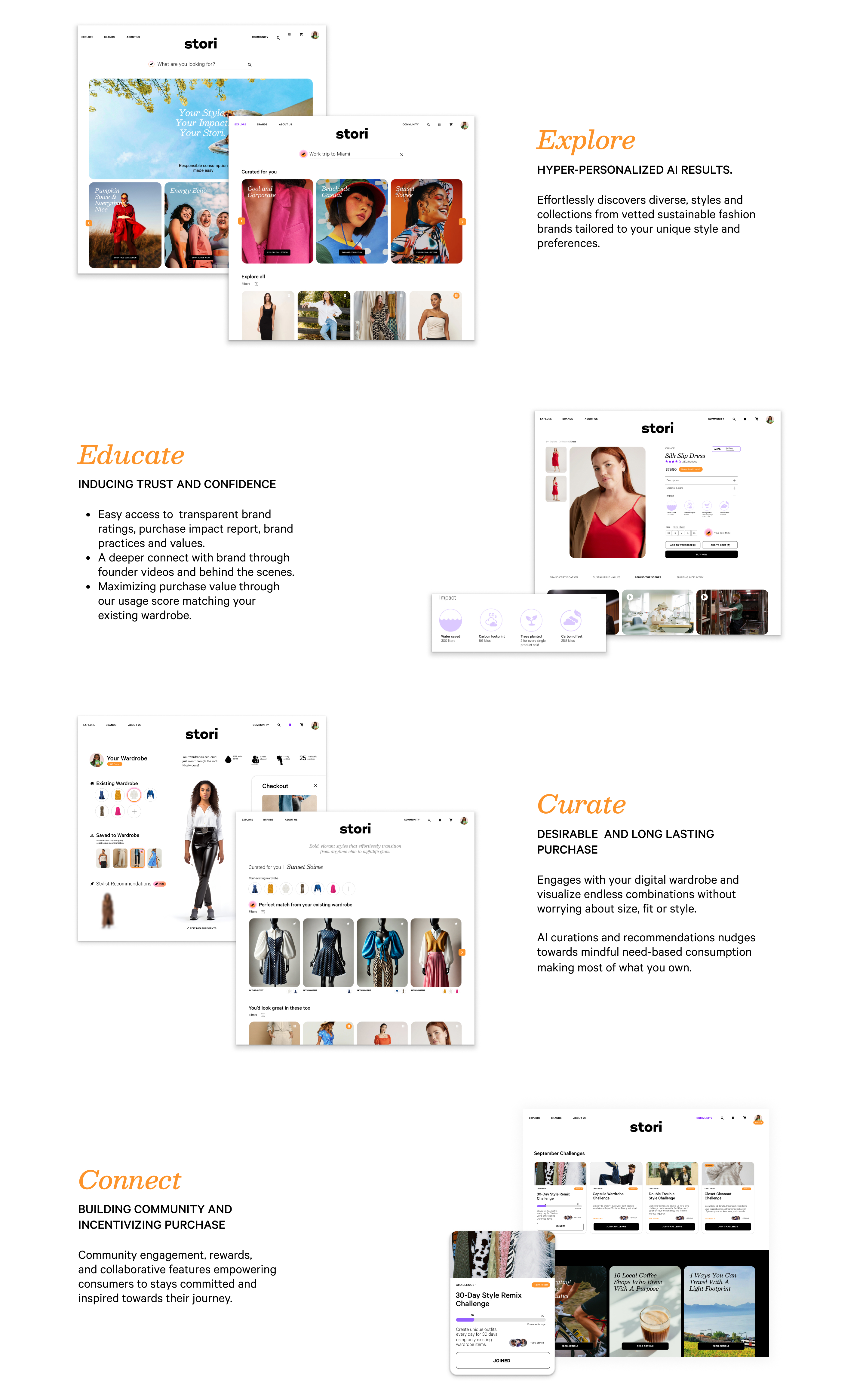
Project Process

Secondary research
I conducted secondary research in the sustainable fashion industry, examining market trends, future growth opportunities, ESG factors, consumer challenges, and brand concerns to identify gaps in the industry and define the project scope and the primary research objectives.
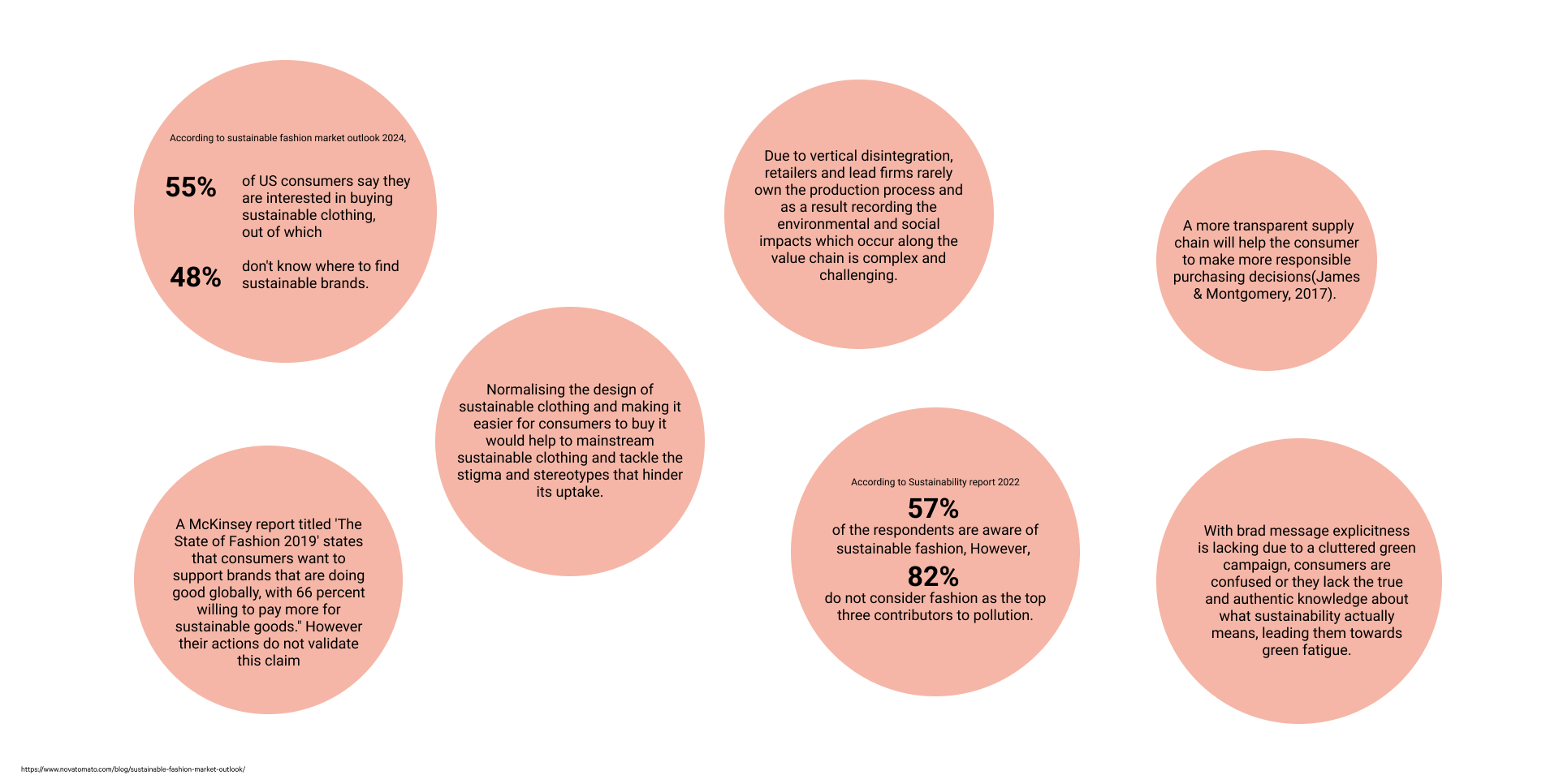
Project Scope
The project will focus on unpacking the consumers' beliefs, purchasing behaviours towards sustainable fashion and the attributes acting as barriers to translating their values into actions.Primary Research
The goal was to dig deeper into the consumer’s shopping behaviour, their belief systems and the current perception of sustainable fashion. Along with the consumers, I also interviewed sustainable fashion brands and experts to understand their challenges, concerns and approach.

In-depth interviews
I conducted interviews with 12 consumers and 3 brand owners to understand and analyse their needs and get an unbiased perspective.
Click to view the interview objectives and discussion guide.︎
I conducted interviews with 12 consumers and 3 brand owners to understand and analyse their needs and get an unbiased perspective.
Click to view the interview objectives and discussion guide.︎
Insights from Interviews
I synthesized data from in-depth interviews to identify 8 key insights and 6 core consumer challenges.
The Foggs' behaviour model (by Dr BJ FOGG) states that behaviour happens when motivation, ability and prompt come together at the same time. Keeping that in mind, I categorized these challenges under these three factors that govern the consumers’ purchasing behaviour.
To know more about the insights, click here︎

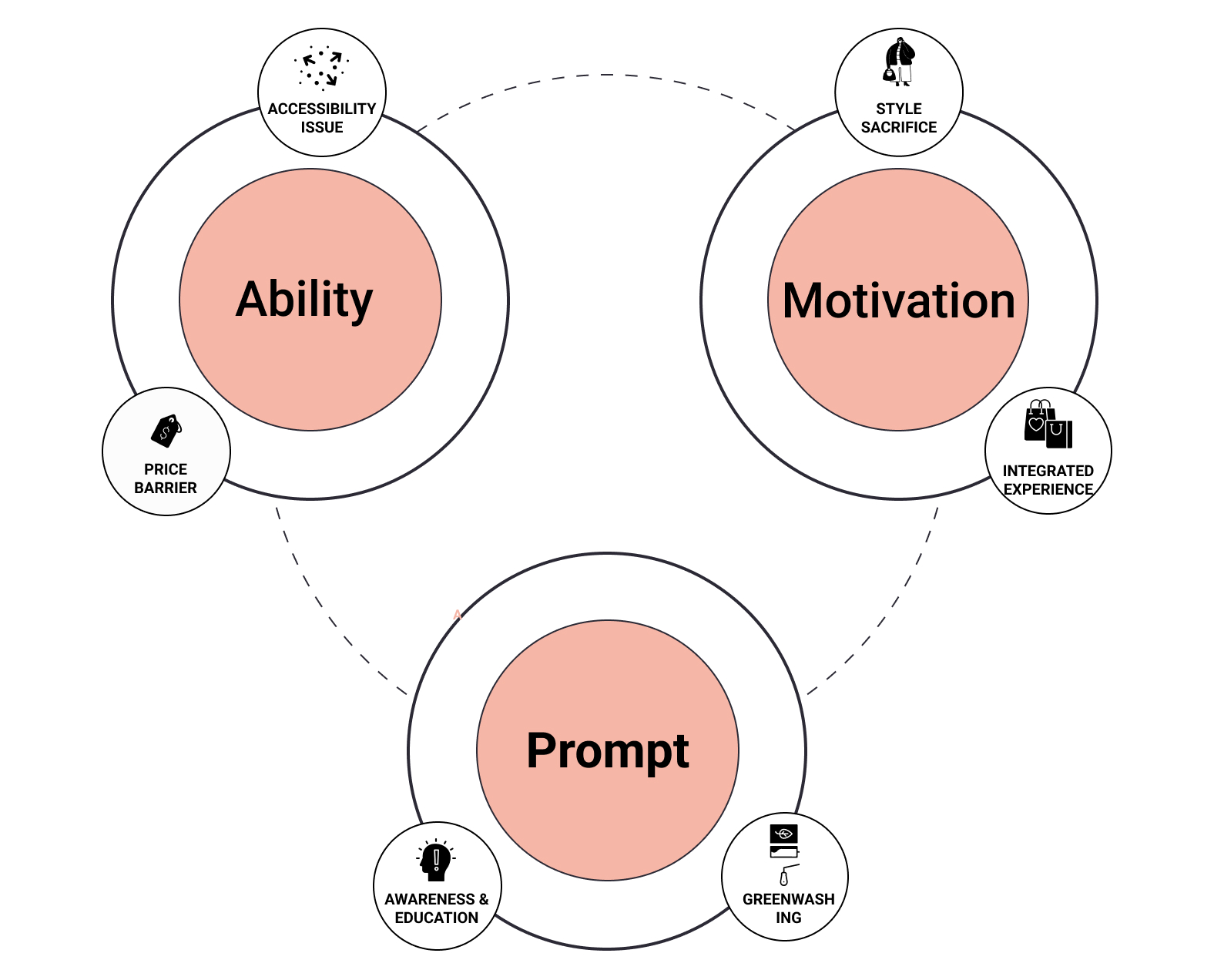
“The deciding factor is how good it looks on me. If they look really good, like on the scale of 1,0, if it's above 7, and if it's slightly on the expensive side, I will invest in it, because I know that this is something that I'm going to wear in the long run.”
- Anonymous Gen Z
- Anonymous Gen Z
Today I would purchase something if I were investing in this item, not just because it has to fit perfectly into my wardrob,e but also I feel like I should know how my purchases are doing more good environmentally and socially
- Anonymous Millennial
- Anonymous Millennial
Market Analysis
I conducted a market analysis using the blue ocean strategy canvas concerning the identified KPIs from my primary research. This was done to identify opportunities in the brand’s approach & practices and build a foundation for the ideation phase.
Current market
The existing brands lack the engagement and excitement that consumers seek. In addition, most of the brands have a social media presence but lack brand appeal due to low product offerings.
![Market analysis]()
The existing brands lack the engagement and excitement that consumers seek. In addition, most of the brands have a social media presence but lack brand appeal due to low product offerings.

Opportunity areas
Using the E.R.I.C analysis, I identified the opportunity spaces where the current market was lacking. These are the areas where I can develop strategies for brands to bridge the gap.
![Opportunity area]()

Mindset Persona
I identified my user groups on the scale of Curiosity v/s Unconcerned, Want-based and Unplanned Consumption v/s Need-based and Planned Consumption. Based on these groups, I designed mindset personas understanding their behaviours, needs and values.



Existing Customer Journey Map
I crafted an existing user journey map based on interviews and personas. By visualizing the consumer’s current actions, pain points and touchpoints across digital and physical interaction, I found areas of improvement and a deeper understanding of their behaviours across the purchase journey.
I crafted an existing user journey map based on interviews and personas. By visualizing the consumer’s current actions, pain points and touchpoints across digital and physical interaction, I found areas of improvement and a deeper understanding of their behaviours across the purchase journey.

Design Concepts
I defined three concepts to further drive the project, based on opportunities and the key findings identified from the primary research. I evaluated these concepts based on design criteria and a 2 X 2 time v/s impact matrix to ideate the most desirable, viable and feasible concept for the customers and brands.
Finalized concept
Based on the findings and insights, I committed to building on the ideal sustainable fashion-buying experience. In addition, I formulated a comprehensive framework that encapsulates the essential attributes and features of an ideal shopping experience.
Based on the findings and insights, I committed to building on the ideal sustainable fashion-buying experience. In addition, I formulated a comprehensive framework that encapsulates the essential attributes and features of an ideal shopping experience.

Ideation
Anchored by four critical design pillars forming the foundation of the customer experience, I brainstormed an extensive array of features, attributes, and services. By strategically mapping these ideas onto a 2x2 matrix, I distilled them to focus on high-impact, high-significance solutions. This rigorous process enabled me to define core and enabling services that directly address fundamental consumer challenges, crafting the blueprint for an ideal shopping experience.
Click to view the value proposition and the zag︎ . Click to view the design pillars and the framework ︎

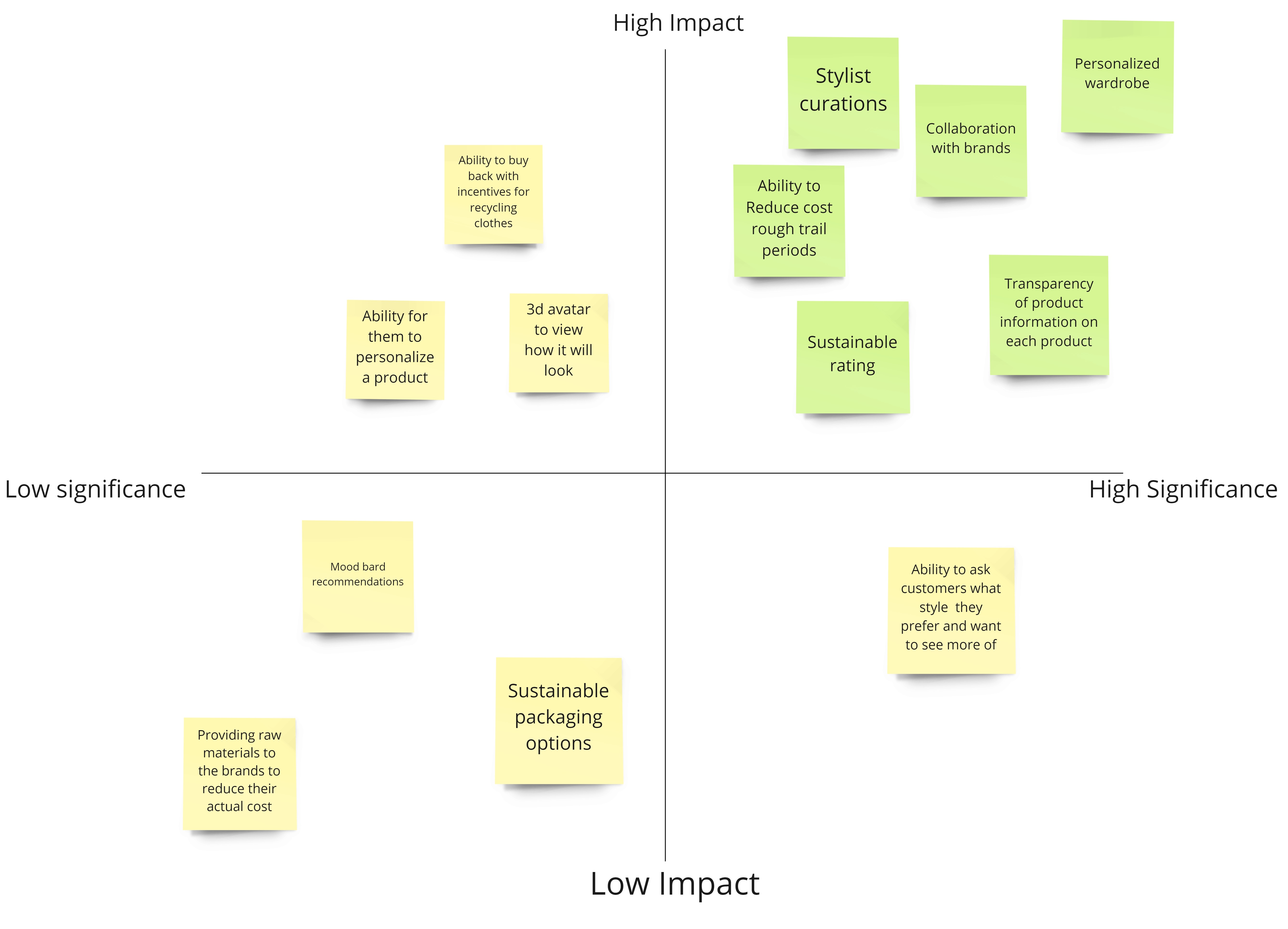
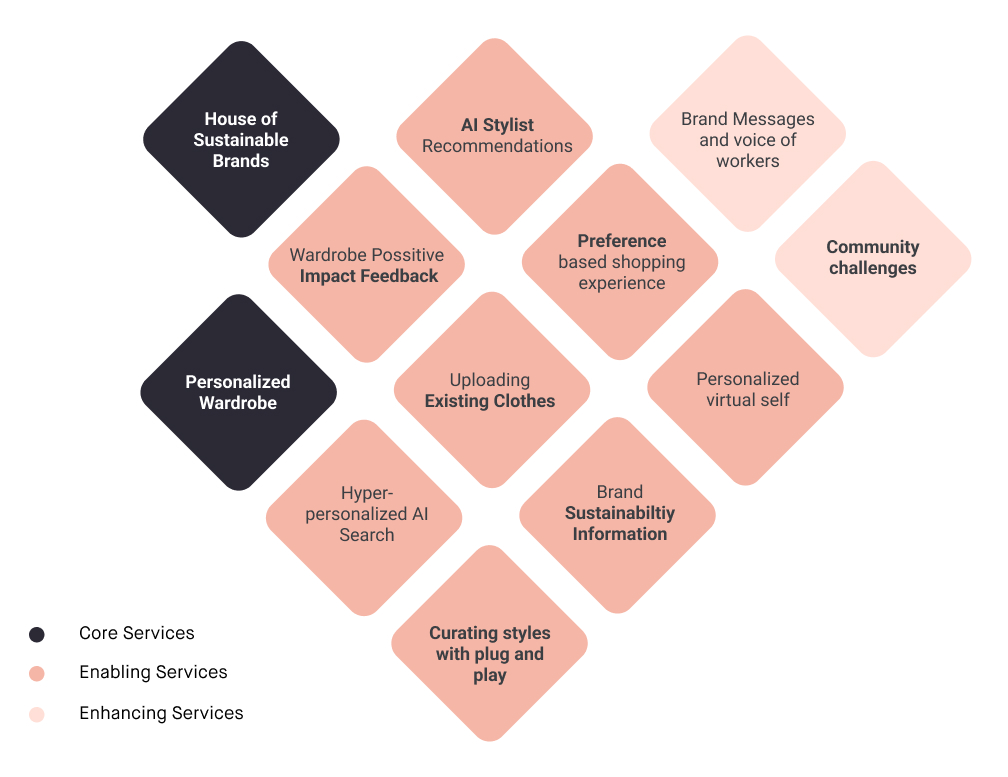
Ideal customer journey map.
Creating engaging and personalized user experiences requires carefully mapping interactions within an ideal customer journey. This process ensures that each step and interaction, from onboarding to purchase, is intuitive and seamless. Based on the existing consumer journey, behavior patterns, and pain points, I strategically mapped our features, key elements, and actions

Sketching and Prototype
After mapping the user journey, I moved towards sketching and prototyping. This helped me visualize customers' interaction with the AI search feature, their virtual self and nudges towards a responsible choice within the interface. I focused on designing high-fidelity prototypes, aligning with the user flow and ensuring the customers were engaged and informed at each step.
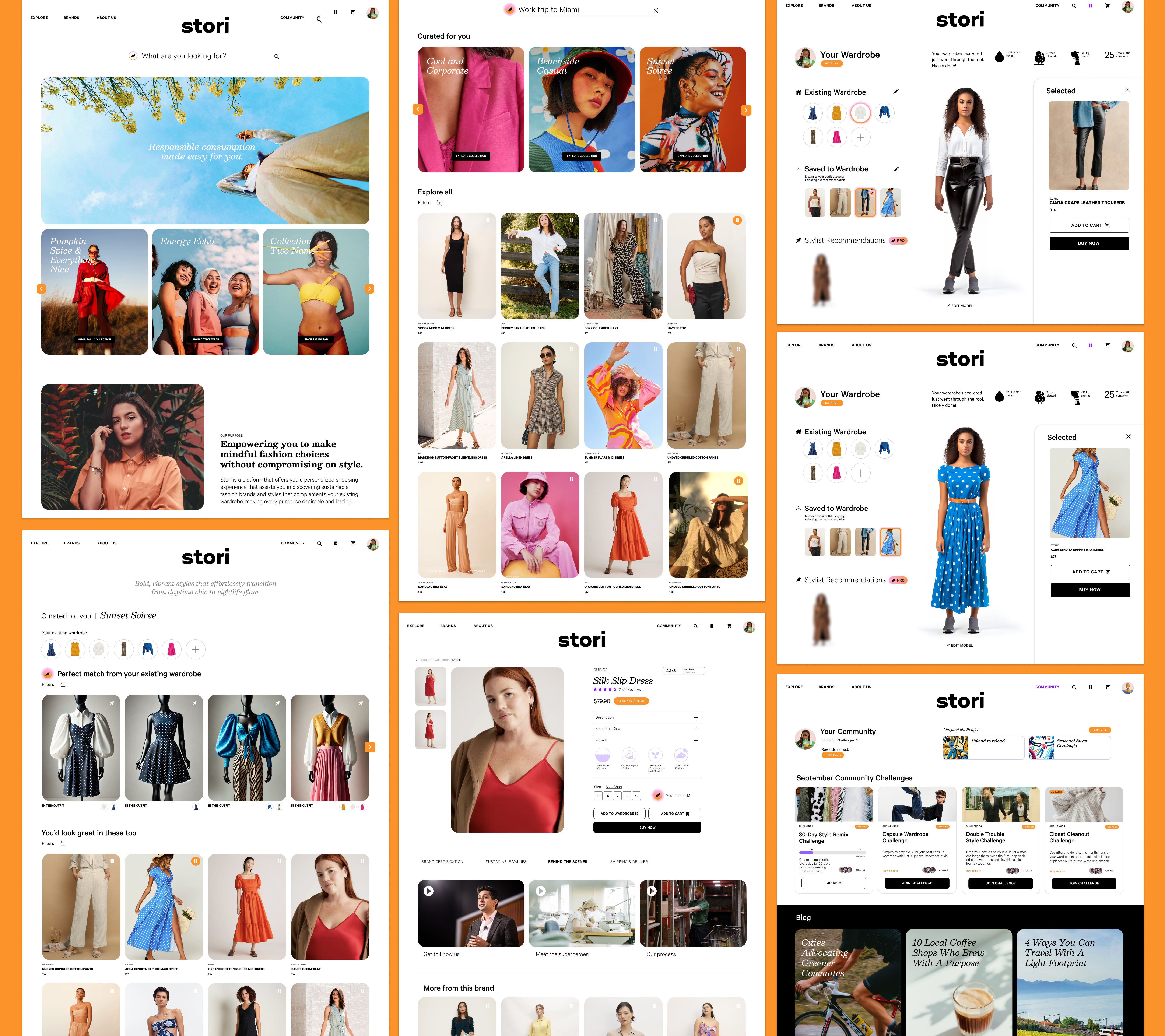
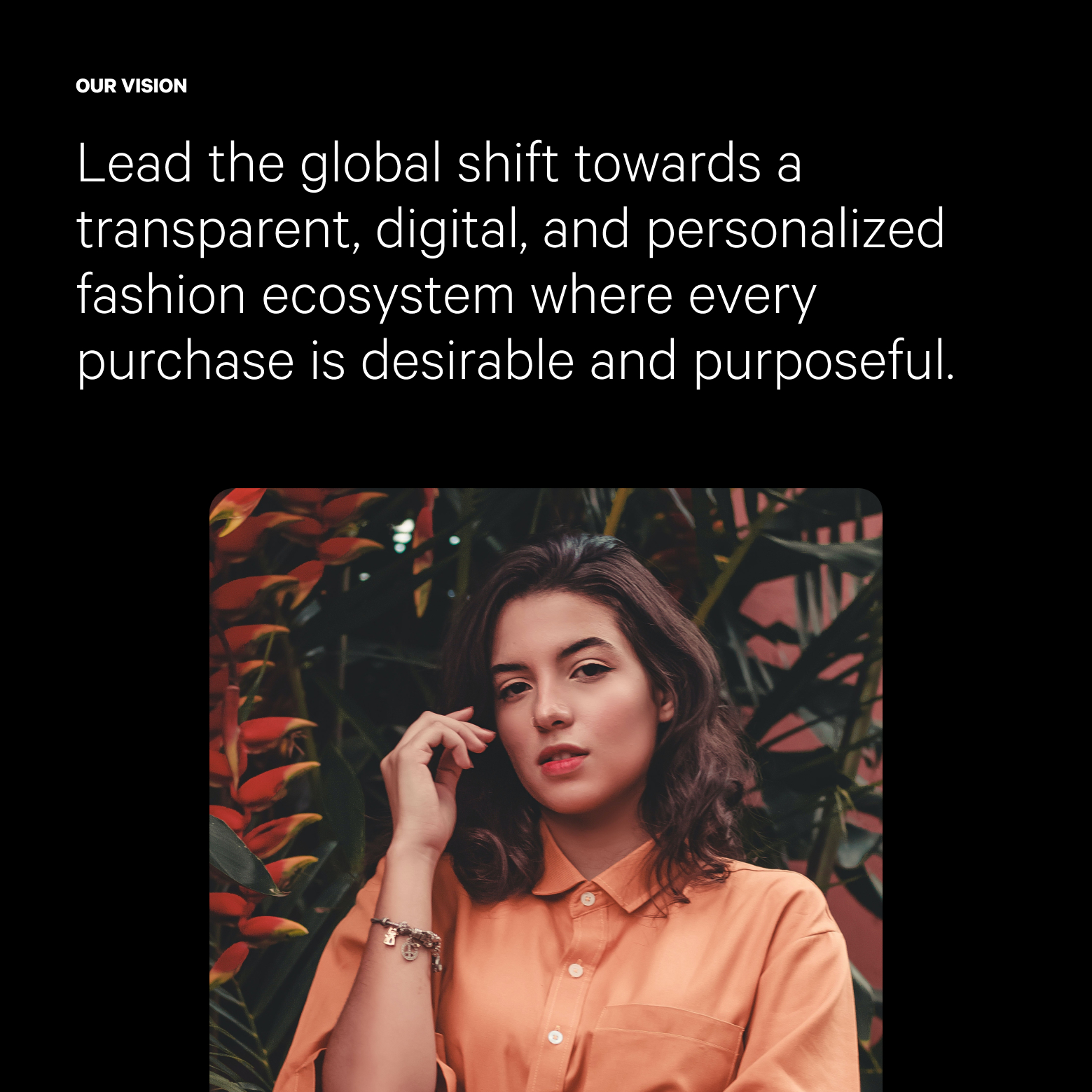
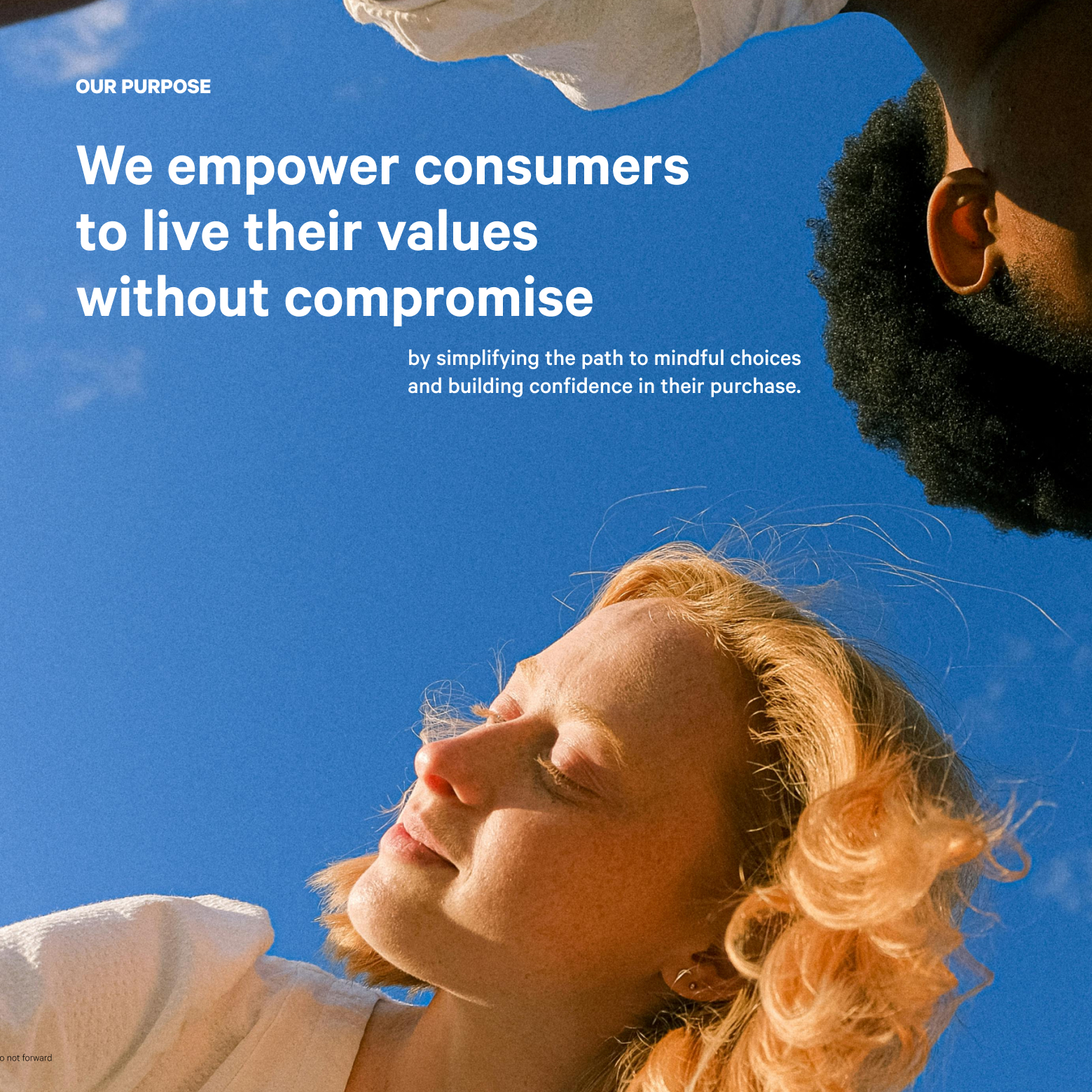
My key learnings
-Strengthened my research skills by not being biased by my self-thoughts while defining insights.
-Always refer back to the research and the problem you are solving when facing challenges with the solution.
-Trusting the process and using the right tools/methods is crucial towards designing a desirable, feasible and viable solution.
-Gained confidence in owning the entire design thinking process and trusting my analysis to justify my decisions.
Images used in the solution are just for representation purposes. The information in the mockups is for reference and conceptual purposes only.
Image Credits: https://modesens.com/reformation-women-clothing/,https://www.anjelms.com/, https://www.quince.com/, https://www.ableclothing.com/, https://thestandardstitch.com/, https://seamsfriendly.com/ , https://unsplash.com/, https://www.pexels.com/
Image Credits: https://modesens.com/reformation-women-clothing/,https://www.anjelms.com/, https://www.quince.com/, https://www.ableclothing.com/, https://thestandardstitch.com/, https://seamsfriendly.com/ , https://unsplash.com/, https://www.pexels.com/
Made by Ojas Gupta, 2024


